Effective Business Communication: Diagnostic Tools and Findings Report
VerifiedAdded on 2020/03/28
|15
|3430
|39
Report
AI Summary
This report, titled "Effective Business Communication," delves into the nuances of communication within a business context. It begins with an examination of various communication styles, including mediators, analyzers, socializers, and aggressor-asserters, and offers strategies for effective interaction with each. The report then introduces communication diagnostic tools, emphasizing the importance of planning, message construction, channel selection, and active listening. Findings from the analysis highlight the need for improved message clarity and enhanced listening skills. A literature review explores the significance of both listening and general communication skills, providing models and techniques for improvement in each area. The report also addresses the importance of adapting communication styles to different audiences and situations, emphasizing the need for clarity, conciseness, and confidence. It concludes by underscoring the importance of active engagement, clear articulation, and storytelling in fostering effective communication.
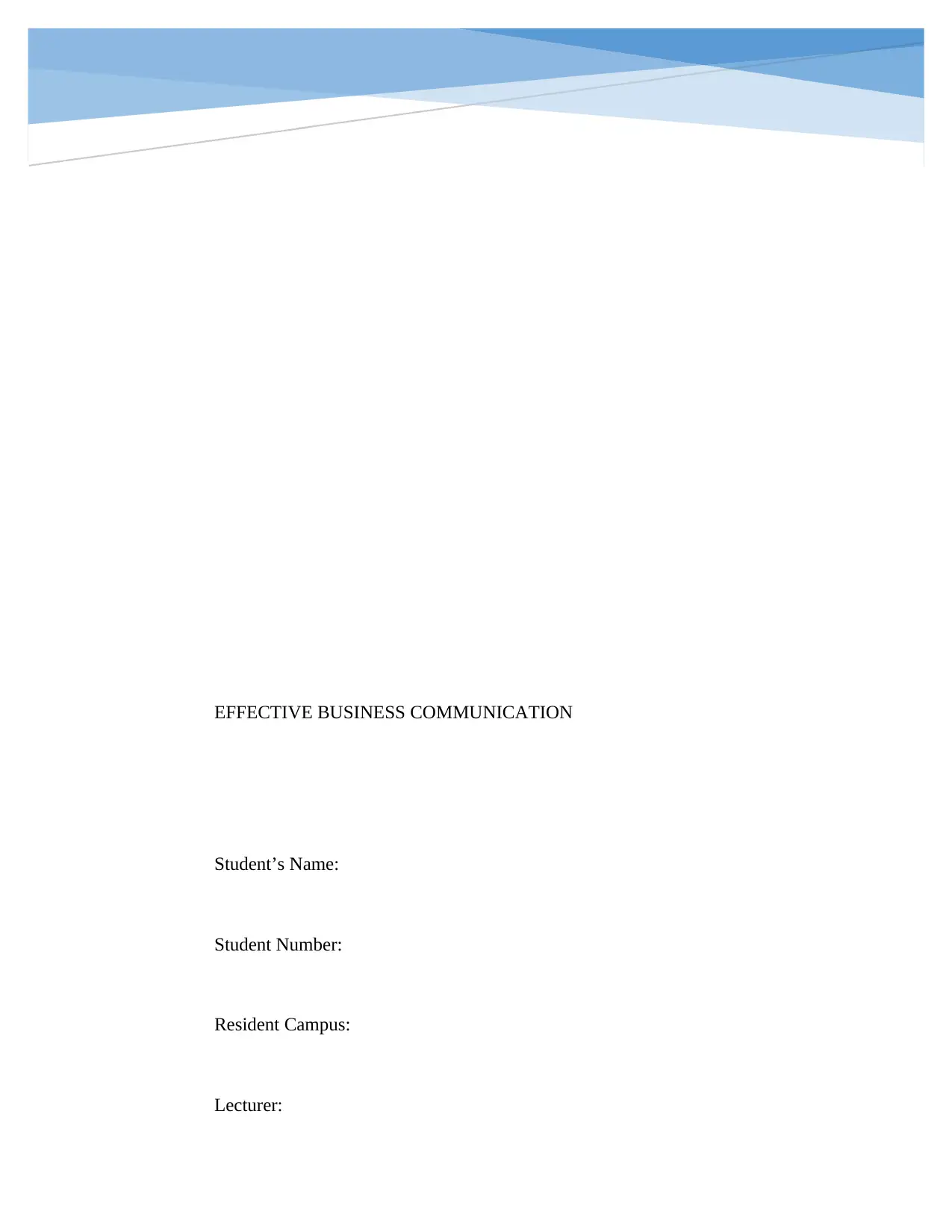
runnhh0
EFFECTIVE BUSINESS COMMUNICATION
Student’s Name:
Student Number:
Resident Campus:
Lecturer:
EFFECTIVE BUSINESS COMMUNICATION
Student’s Name:
Student Number:
Resident Campus:
Lecturer:
Secure Best Marks with AI Grader
Need help grading? Try our AI Grader for instant feedback on your assignments.
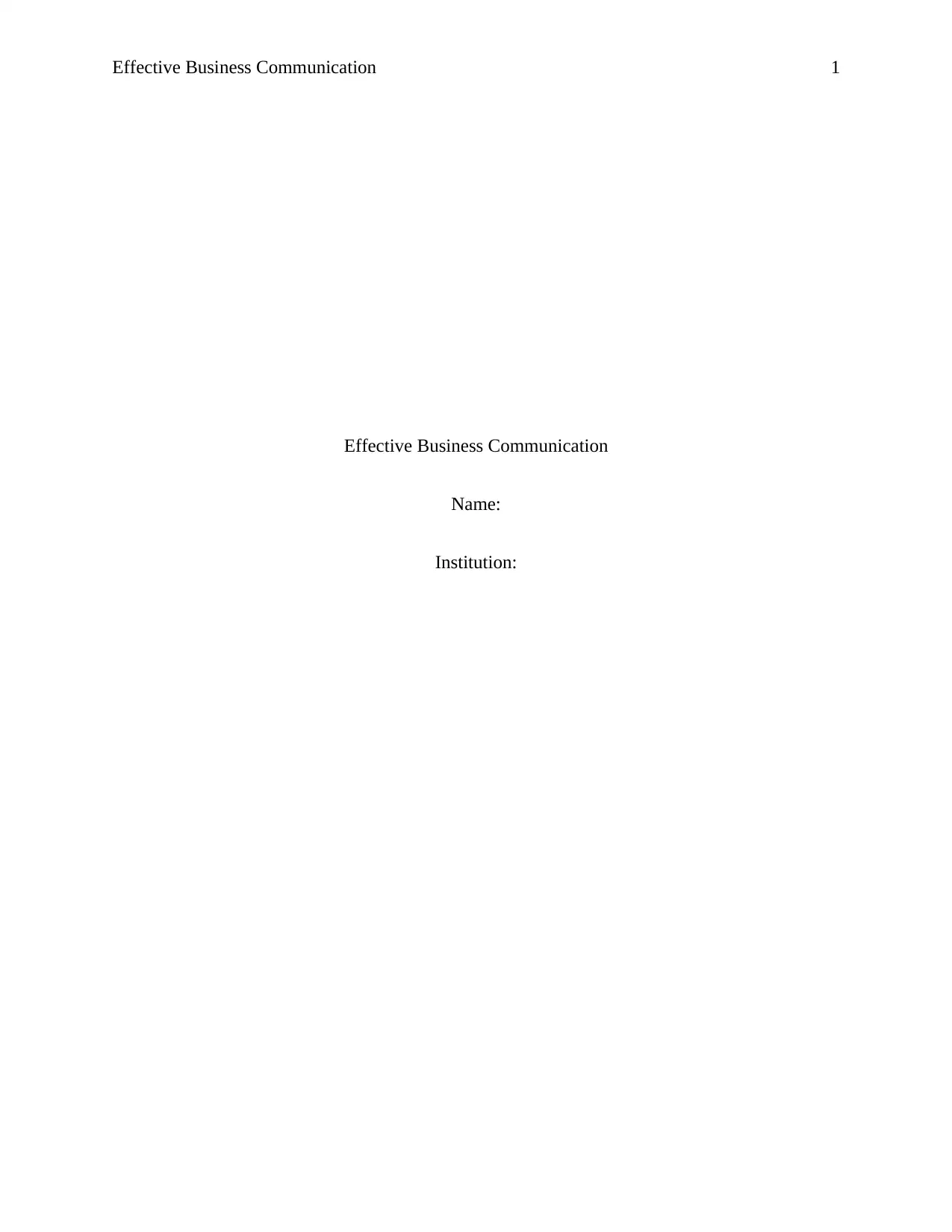
Effective Business Communication 1
Effective Business Communication
Name:
Institution:
Effective Business Communication
Name:
Institution:
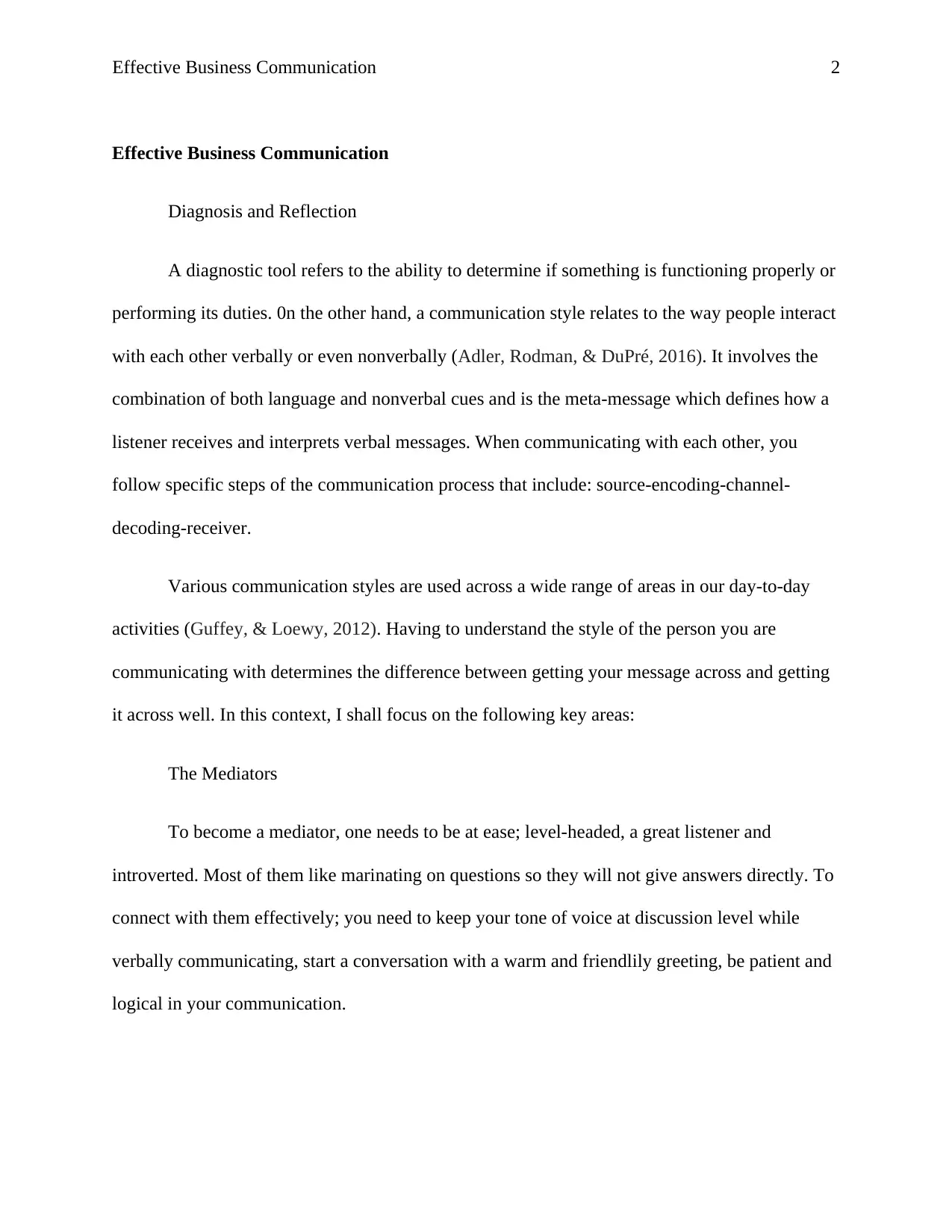
Effective Business Communication 2
Effective Business Communication
Diagnosis and Reflection
A diagnostic tool refers to the ability to determine if something is functioning properly or
performing its duties. 0n the other hand, a communication style relates to the way people interact
with each other verbally or even nonverbally (Adler, Rodman, & DuPré, 2016). It involves the
combination of both language and nonverbal cues and is the meta-message which defines how a
listener receives and interprets verbal messages. When communicating with each other, you
follow specific steps of the communication process that include: source-encoding-channel-
decoding-receiver.
Various communication styles are used across a wide range of areas in our day-to-day
activities (Guffey, & Loewy, 2012). Having to understand the style of the person you are
communicating with determines the difference between getting your message across and getting
it across well. In this context, I shall focus on the following key areas:
The Mediators
To become a mediator, one needs to be at ease; level-headed, a great listener and
introverted. Most of them like marinating on questions so they will not give answers directly. To
connect with them effectively; you need to keep your tone of voice at discussion level while
verbally communicating, start a conversation with a warm and friendlily greeting, be patient and
logical in your communication.
Effective Business Communication
Diagnosis and Reflection
A diagnostic tool refers to the ability to determine if something is functioning properly or
performing its duties. 0n the other hand, a communication style relates to the way people interact
with each other verbally or even nonverbally (Adler, Rodman, & DuPré, 2016). It involves the
combination of both language and nonverbal cues and is the meta-message which defines how a
listener receives and interprets verbal messages. When communicating with each other, you
follow specific steps of the communication process that include: source-encoding-channel-
decoding-receiver.
Various communication styles are used across a wide range of areas in our day-to-day
activities (Guffey, & Loewy, 2012). Having to understand the style of the person you are
communicating with determines the difference between getting your message across and getting
it across well. In this context, I shall focus on the following key areas:
The Mediators
To become a mediator, one needs to be at ease; level-headed, a great listener and
introverted. Most of them like marinating on questions so they will not give answers directly. To
connect with them effectively; you need to keep your tone of voice at discussion level while
verbally communicating, start a conversation with a warm and friendlily greeting, be patient and
logical in your communication.
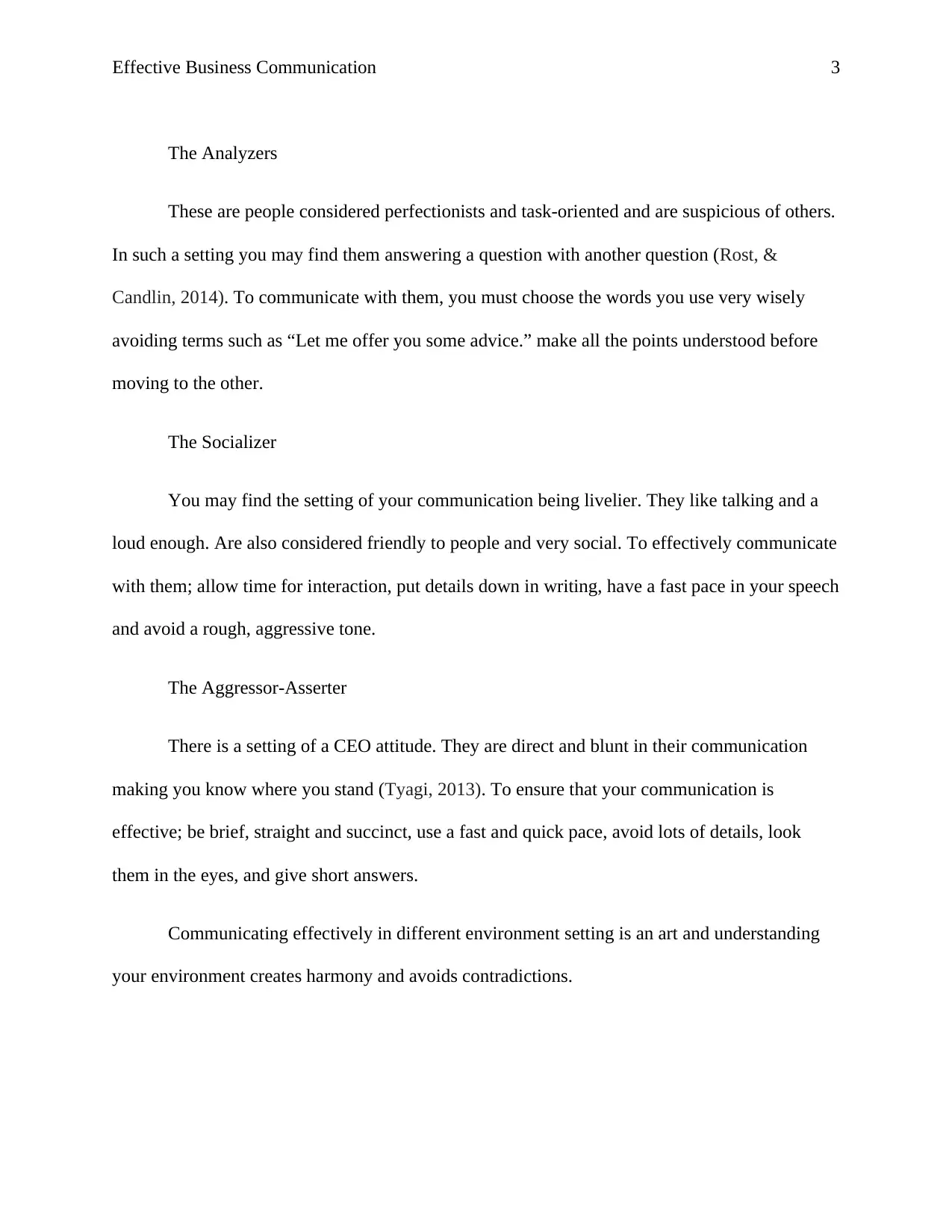
Effective Business Communication 3
The Analyzers
These are people considered perfectionists and task-oriented and are suspicious of others.
In such a setting you may find them answering a question with another question (Rost, &
Candlin, 2014). To communicate with them, you must choose the words you use very wisely
avoiding terms such as “Let me offer you some advice.” make all the points understood before
moving to the other.
The Socializer
You may find the setting of your communication being livelier. They like talking and a
loud enough. Are also considered friendly to people and very social. To effectively communicate
with them; allow time for interaction, put details down in writing, have a fast pace in your speech
and avoid a rough, aggressive tone.
The Aggressor-Asserter
There is a setting of a CEO attitude. They are direct and blunt in their communication
making you know where you stand (Tyagi, 2013). To ensure that your communication is
effective; be brief, straight and succinct, use a fast and quick pace, avoid lots of details, look
them in the eyes, and give short answers.
Communicating effectively in different environment setting is an art and understanding
your environment creates harmony and avoids contradictions.
The Analyzers
These are people considered perfectionists and task-oriented and are suspicious of others.
In such a setting you may find them answering a question with another question (Rost, &
Candlin, 2014). To communicate with them, you must choose the words you use very wisely
avoiding terms such as “Let me offer you some advice.” make all the points understood before
moving to the other.
The Socializer
You may find the setting of your communication being livelier. They like talking and a
loud enough. Are also considered friendly to people and very social. To effectively communicate
with them; allow time for interaction, put details down in writing, have a fast pace in your speech
and avoid a rough, aggressive tone.
The Aggressor-Asserter
There is a setting of a CEO attitude. They are direct and blunt in their communication
making you know where you stand (Tyagi, 2013). To ensure that your communication is
effective; be brief, straight and succinct, use a fast and quick pace, avoid lots of details, look
them in the eyes, and give short answers.
Communicating effectively in different environment setting is an art and understanding
your environment creates harmony and avoids contradictions.
Secure Best Marks with AI Grader
Need help grading? Try our AI Grader for instant feedback on your assignments.
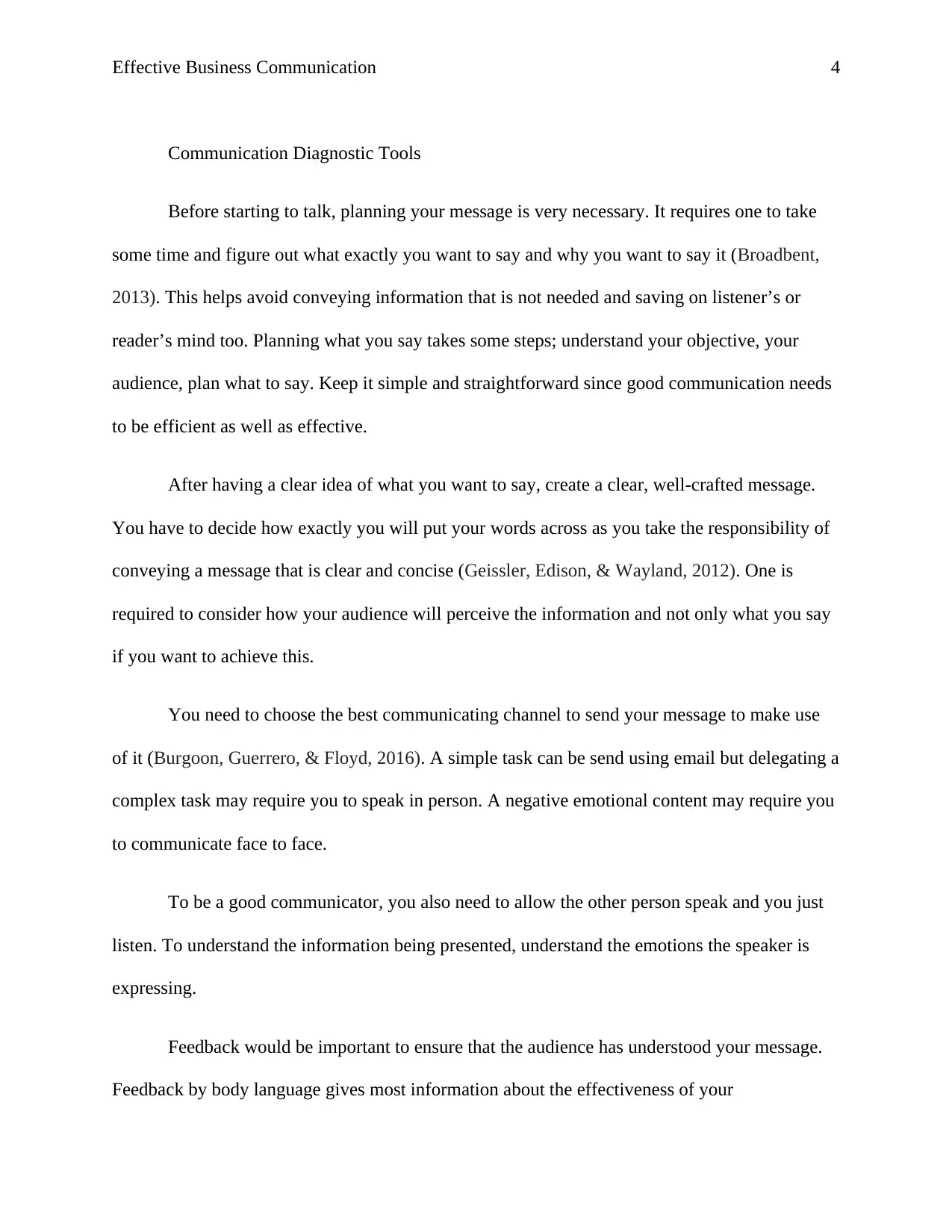
Effective Business Communication 4
Communication Diagnostic Tools
Before starting to talk, planning your message is very necessary. It requires one to take
some time and figure out what exactly you want to say and why you want to say it (Broadbent,
2013). This helps avoid conveying information that is not needed and saving on listener’s or
reader’s mind too. Planning what you say takes some steps; understand your objective, your
audience, plan what to say. Keep it simple and straightforward since good communication needs
to be efficient as well as effective.
After having a clear idea of what you want to say, create a clear, well-crafted message.
You have to decide how exactly you will put your words across as you take the responsibility of
conveying a message that is clear and concise (Geissler, Edison, & Wayland, 2012). One is
required to consider how your audience will perceive the information and not only what you say
if you want to achieve this.
You need to choose the best communicating channel to send your message to make use
of it (Burgoon, Guerrero, & Floyd, 2016). A simple task can be send using email but delegating a
complex task may require you to speak in person. A negative emotional content may require you
to communicate face to face.
To be a good communicator, you also need to allow the other person speak and you just
listen. To understand the information being presented, understand the emotions the speaker is
expressing.
Feedback would be important to ensure that the audience has understood your message.
Feedback by body language gives most information about the effectiveness of your
Communication Diagnostic Tools
Before starting to talk, planning your message is very necessary. It requires one to take
some time and figure out what exactly you want to say and why you want to say it (Broadbent,
2013). This helps avoid conveying information that is not needed and saving on listener’s or
reader’s mind too. Planning what you say takes some steps; understand your objective, your
audience, plan what to say. Keep it simple and straightforward since good communication needs
to be efficient as well as effective.
After having a clear idea of what you want to say, create a clear, well-crafted message.
You have to decide how exactly you will put your words across as you take the responsibility of
conveying a message that is clear and concise (Geissler, Edison, & Wayland, 2012). One is
required to consider how your audience will perceive the information and not only what you say
if you want to achieve this.
You need to choose the best communicating channel to send your message to make use
of it (Burgoon, Guerrero, & Floyd, 2016). A simple task can be send using email but delegating a
complex task may require you to speak in person. A negative emotional content may require you
to communicate face to face.
To be a good communicator, you also need to allow the other person speak and you just
listen. To understand the information being presented, understand the emotions the speaker is
expressing.
Feedback would be important to ensure that the audience has understood your message.
Feedback by body language gives most information about the effectiveness of your
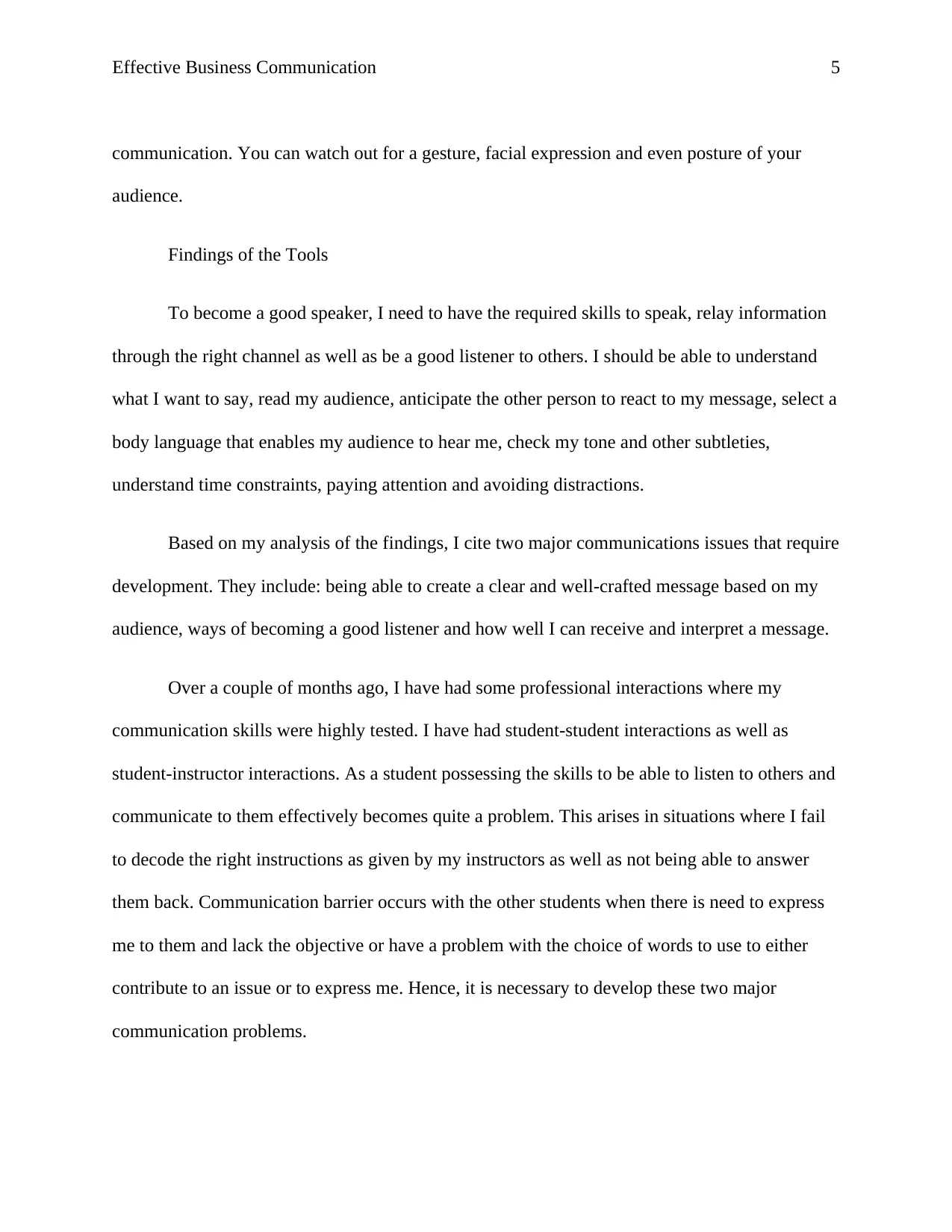
Effective Business Communication 5
communication. You can watch out for a gesture, facial expression and even posture of your
audience.
Findings of the Tools
To become a good speaker, I need to have the required skills to speak, relay information
through the right channel as well as be a good listener to others. I should be able to understand
what I want to say, read my audience, anticipate the other person to react to my message, select a
body language that enables my audience to hear me, check my tone and other subtleties,
understand time constraints, paying attention and avoiding distractions.
Based on my analysis of the findings, I cite two major communications issues that require
development. They include: being able to create a clear and well-crafted message based on my
audience, ways of becoming a good listener and how well I can receive and interpret a message.
Over a couple of months ago, I have had some professional interactions where my
communication skills were highly tested. I have had student-student interactions as well as
student-instructor interactions. As a student possessing the skills to be able to listen to others and
communicate to them effectively becomes quite a problem. This arises in situations where I fail
to decode the right instructions as given by my instructors as well as not being able to answer
them back. Communication barrier occurs with the other students when there is need to express
me to them and lack the objective or have a problem with the choice of words to use to either
contribute to an issue or to express me. Hence, it is necessary to develop these two major
communication problems.
communication. You can watch out for a gesture, facial expression and even posture of your
audience.
Findings of the Tools
To become a good speaker, I need to have the required skills to speak, relay information
through the right channel as well as be a good listener to others. I should be able to understand
what I want to say, read my audience, anticipate the other person to react to my message, select a
body language that enables my audience to hear me, check my tone and other subtleties,
understand time constraints, paying attention and avoiding distractions.
Based on my analysis of the findings, I cite two major communications issues that require
development. They include: being able to create a clear and well-crafted message based on my
audience, ways of becoming a good listener and how well I can receive and interpret a message.
Over a couple of months ago, I have had some professional interactions where my
communication skills were highly tested. I have had student-student interactions as well as
student-instructor interactions. As a student possessing the skills to be able to listen to others and
communicate to them effectively becomes quite a problem. This arises in situations where I fail
to decode the right instructions as given by my instructors as well as not being able to answer
them back. Communication barrier occurs with the other students when there is need to express
me to them and lack the objective or have a problem with the choice of words to use to either
contribute to an issue or to express me. Hence, it is necessary to develop these two major
communication problems.
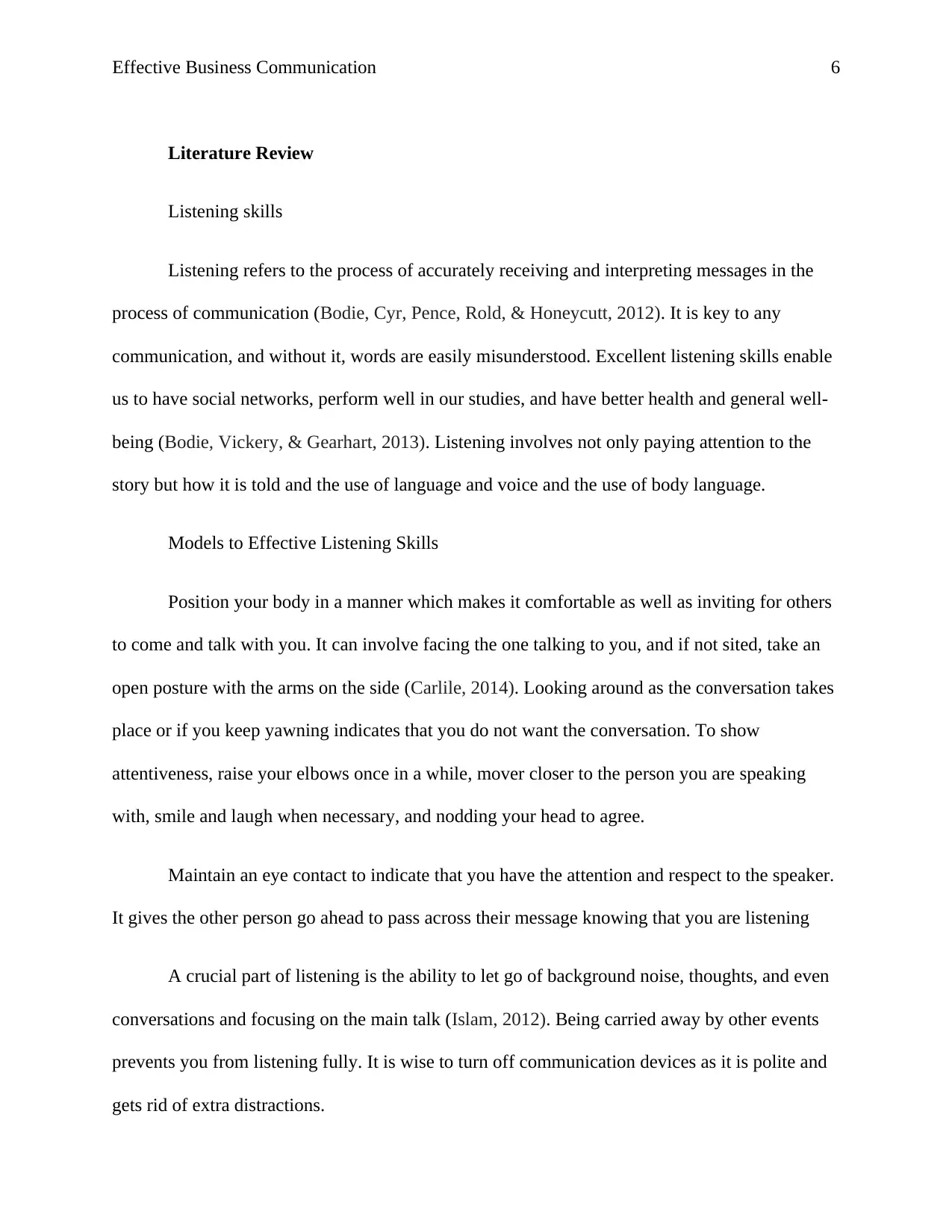
Effective Business Communication 6
Literature Review
Listening skills
Listening refers to the process of accurately receiving and interpreting messages in the
process of communication (Bodie, Cyr, Pence, Rold, & Honeycutt, 2012). It is key to any
communication, and without it, words are easily misunderstood. Excellent listening skills enable
us to have social networks, perform well in our studies, and have better health and general well-
being (Bodie, Vickery, & Gearhart, 2013). Listening involves not only paying attention to the
story but how it is told and the use of language and voice and the use of body language.
Models to Effective Listening Skills
Position your body in a manner which makes it comfortable as well as inviting for others
to come and talk with you. It can involve facing the one talking to you, and if not sited, take an
open posture with the arms on the side (Carlile, 2014). Looking around as the conversation takes
place or if you keep yawning indicates that you do not want the conversation. To show
attentiveness, raise your elbows once in a while, mover closer to the person you are speaking
with, smile and laugh when necessary, and nodding your head to agree.
Maintain an eye contact to indicate that you have the attention and respect to the speaker.
It gives the other person go ahead to pass across their message knowing that you are listening
A crucial part of listening is the ability to let go of background noise, thoughts, and even
conversations and focusing on the main talk (Islam, 2012). Being carried away by other events
prevents you from listening fully. It is wise to turn off communication devices as it is polite and
gets rid of extra distractions.
Literature Review
Listening skills
Listening refers to the process of accurately receiving and interpreting messages in the
process of communication (Bodie, Cyr, Pence, Rold, & Honeycutt, 2012). It is key to any
communication, and without it, words are easily misunderstood. Excellent listening skills enable
us to have social networks, perform well in our studies, and have better health and general well-
being (Bodie, Vickery, & Gearhart, 2013). Listening involves not only paying attention to the
story but how it is told and the use of language and voice and the use of body language.
Models to Effective Listening Skills
Position your body in a manner which makes it comfortable as well as inviting for others
to come and talk with you. It can involve facing the one talking to you, and if not sited, take an
open posture with the arms on the side (Carlile, 2014). Looking around as the conversation takes
place or if you keep yawning indicates that you do not want the conversation. To show
attentiveness, raise your elbows once in a while, mover closer to the person you are speaking
with, smile and laugh when necessary, and nodding your head to agree.
Maintain an eye contact to indicate that you have the attention and respect to the speaker.
It gives the other person go ahead to pass across their message knowing that you are listening
A crucial part of listening is the ability to let go of background noise, thoughts, and even
conversations and focusing on the main talk (Islam, 2012). Being carried away by other events
prevents you from listening fully. It is wise to turn off communication devices as it is polite and
gets rid of extra distractions.
Paraphrase This Document
Need a fresh take? Get an instant paraphrase of this document with our AI Paraphraser
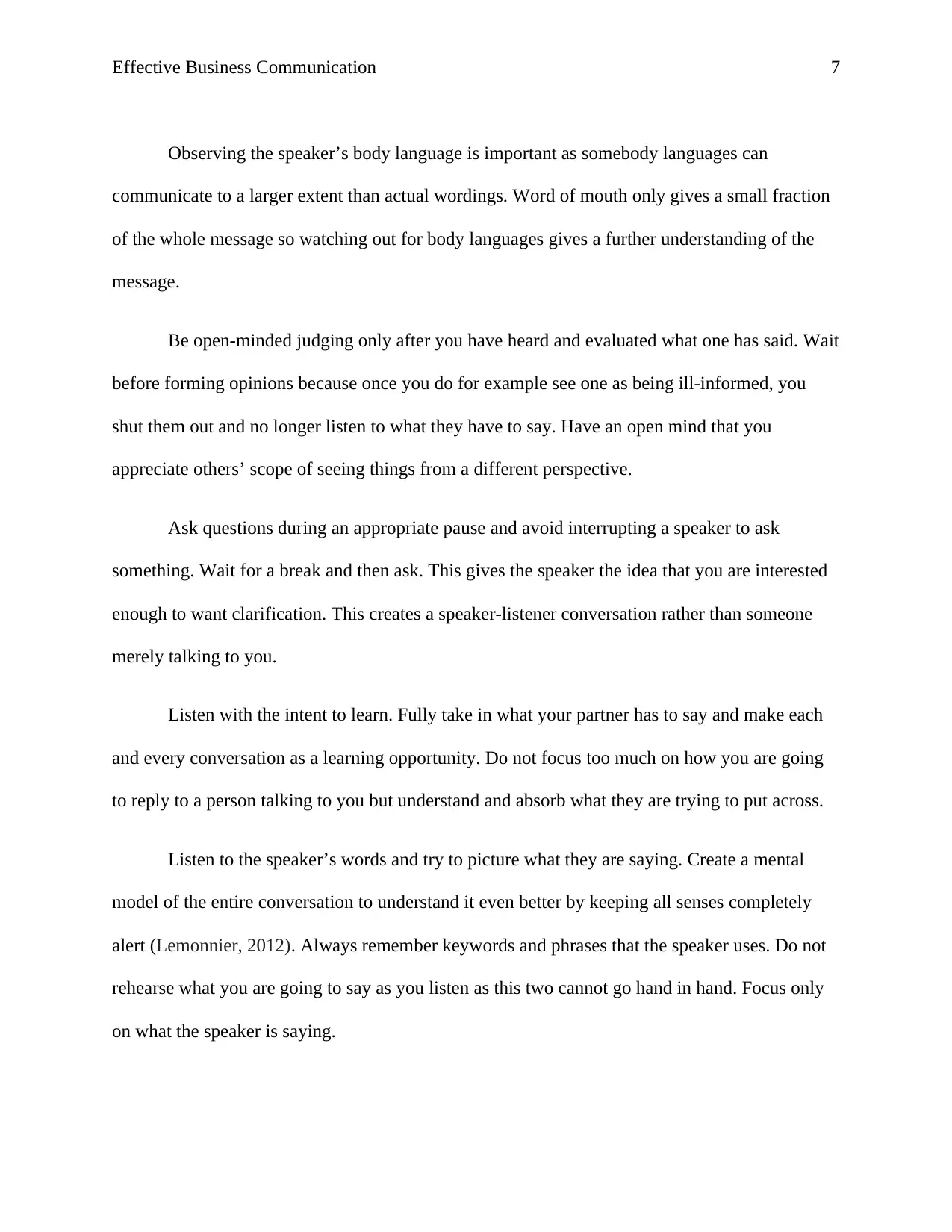
Effective Business Communication 7
Observing the speaker’s body language is important as somebody languages can
communicate to a larger extent than actual wordings. Word of mouth only gives a small fraction
of the whole message so watching out for body languages gives a further understanding of the
message.
Be open-minded judging only after you have heard and evaluated what one has said. Wait
before forming opinions because once you do for example see one as being ill-informed, you
shut them out and no longer listen to what they have to say. Have an open mind that you
appreciate others’ scope of seeing things from a different perspective.
Ask questions during an appropriate pause and avoid interrupting a speaker to ask
something. Wait for a break and then ask. This gives the speaker the idea that you are interested
enough to want clarification. This creates a speaker-listener conversation rather than someone
merely talking to you.
Listen with the intent to learn. Fully take in what your partner has to say and make each
and every conversation as a learning opportunity. Do not focus too much on how you are going
to reply to a person talking to you but understand and absorb what they are trying to put across.
Listen to the speaker’s words and try to picture what they are saying. Create a mental
model of the entire conversation to understand it even better by keeping all senses completely
alert (Lemonnier, 2012). Always remember keywords and phrases that the speaker uses. Do not
rehearse what you are going to say as you listen as this two cannot go hand in hand. Focus only
on what the speaker is saying.
Observing the speaker’s body language is important as somebody languages can
communicate to a larger extent than actual wordings. Word of mouth only gives a small fraction
of the whole message so watching out for body languages gives a further understanding of the
message.
Be open-minded judging only after you have heard and evaluated what one has said. Wait
before forming opinions because once you do for example see one as being ill-informed, you
shut them out and no longer listen to what they have to say. Have an open mind that you
appreciate others’ scope of seeing things from a different perspective.
Ask questions during an appropriate pause and avoid interrupting a speaker to ask
something. Wait for a break and then ask. This gives the speaker the idea that you are interested
enough to want clarification. This creates a speaker-listener conversation rather than someone
merely talking to you.
Listen with the intent to learn. Fully take in what your partner has to say and make each
and every conversation as a learning opportunity. Do not focus too much on how you are going
to reply to a person talking to you but understand and absorb what they are trying to put across.
Listen to the speaker’s words and try to picture what they are saying. Create a mental
model of the entire conversation to understand it even better by keeping all senses completely
alert (Lemonnier, 2012). Always remember keywords and phrases that the speaker uses. Do not
rehearse what you are going to say as you listen as this two cannot go hand in hand. Focus only
on what the speaker is saying.
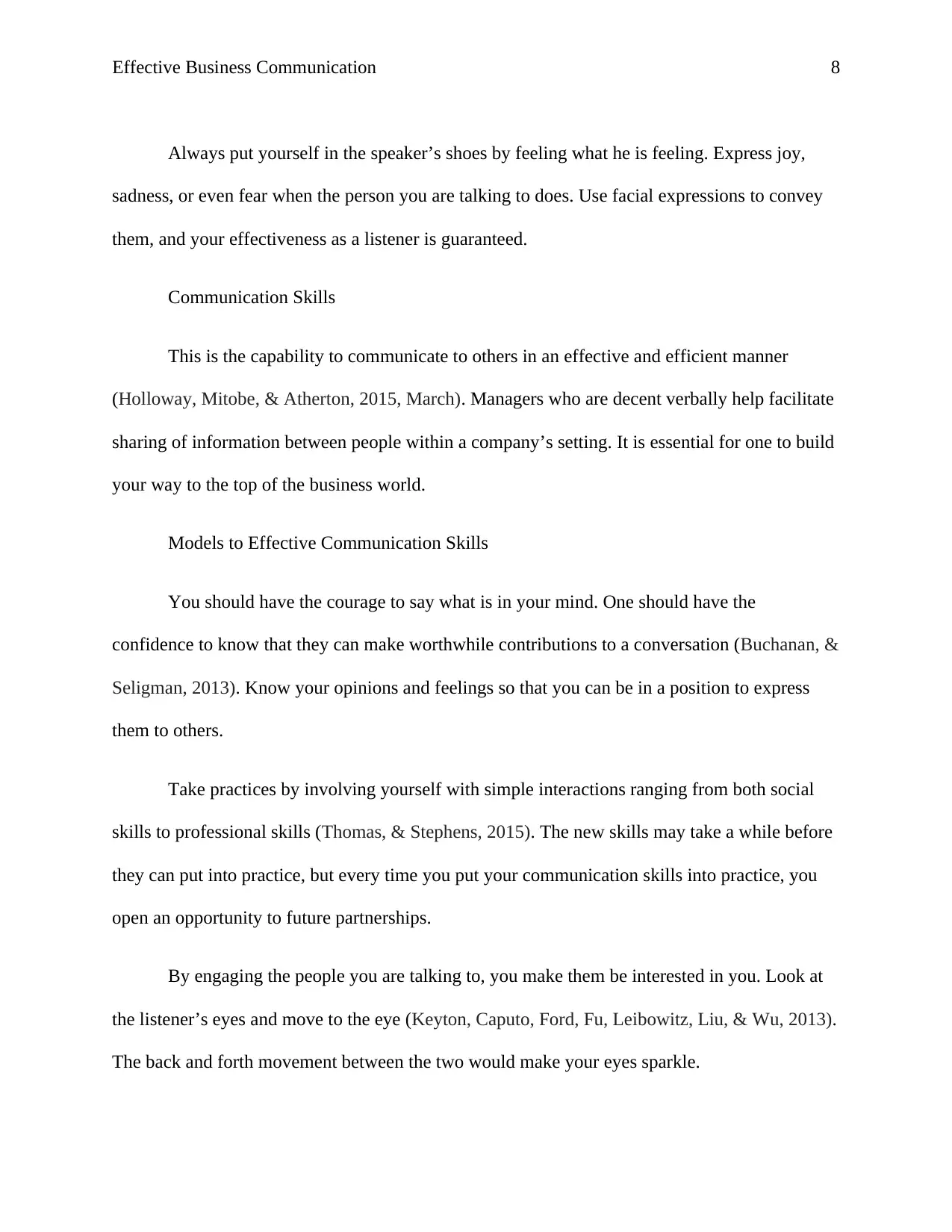
Effective Business Communication 8
Always put yourself in the speaker’s shoes by feeling what he is feeling. Express joy,
sadness, or even fear when the person you are talking to does. Use facial expressions to convey
them, and your effectiveness as a listener is guaranteed.
Communication Skills
This is the capability to communicate to others in an effective and efficient manner
(Holloway, Mitobe, & Atherton, 2015, March). Managers who are decent verbally help facilitate
sharing of information between people within a company’s setting. It is essential for one to build
your way to the top of the business world.
Models to Effective Communication Skills
You should have the courage to say what is in your mind. One should have the
confidence to know that they can make worthwhile contributions to a conversation (Buchanan, &
Seligman, 2013). Know your opinions and feelings so that you can be in a position to express
them to others.
Take practices by involving yourself with simple interactions ranging from both social
skills to professional skills (Thomas, & Stephens, 2015). The new skills may take a while before
they can put into practice, but every time you put your communication skills into practice, you
open an opportunity to future partnerships.
By engaging the people you are talking to, you make them be interested in you. Look at
the listener’s eyes and move to the eye (Keyton, Caputo, Ford, Fu, Leibowitz, Liu, & Wu, 2013).
The back and forth movement between the two would make your eyes sparkle.
Always put yourself in the speaker’s shoes by feeling what he is feeling. Express joy,
sadness, or even fear when the person you are talking to does. Use facial expressions to convey
them, and your effectiveness as a listener is guaranteed.
Communication Skills
This is the capability to communicate to others in an effective and efficient manner
(Holloway, Mitobe, & Atherton, 2015, March). Managers who are decent verbally help facilitate
sharing of information between people within a company’s setting. It is essential for one to build
your way to the top of the business world.
Models to Effective Communication Skills
You should have the courage to say what is in your mind. One should have the
confidence to know that they can make worthwhile contributions to a conversation (Buchanan, &
Seligman, 2013). Know your opinions and feelings so that you can be in a position to express
them to others.
Take practices by involving yourself with simple interactions ranging from both social
skills to professional skills (Thomas, & Stephens, 2015). The new skills may take a while before
they can put into practice, but every time you put your communication skills into practice, you
open an opportunity to future partnerships.
By engaging the people you are talking to, you make them be interested in you. Look at
the listener’s eyes and move to the eye (Keyton, Caputo, Ford, Fu, Leibowitz, Liu, & Wu, 2013).
The back and forth movement between the two would make your eyes sparkle.
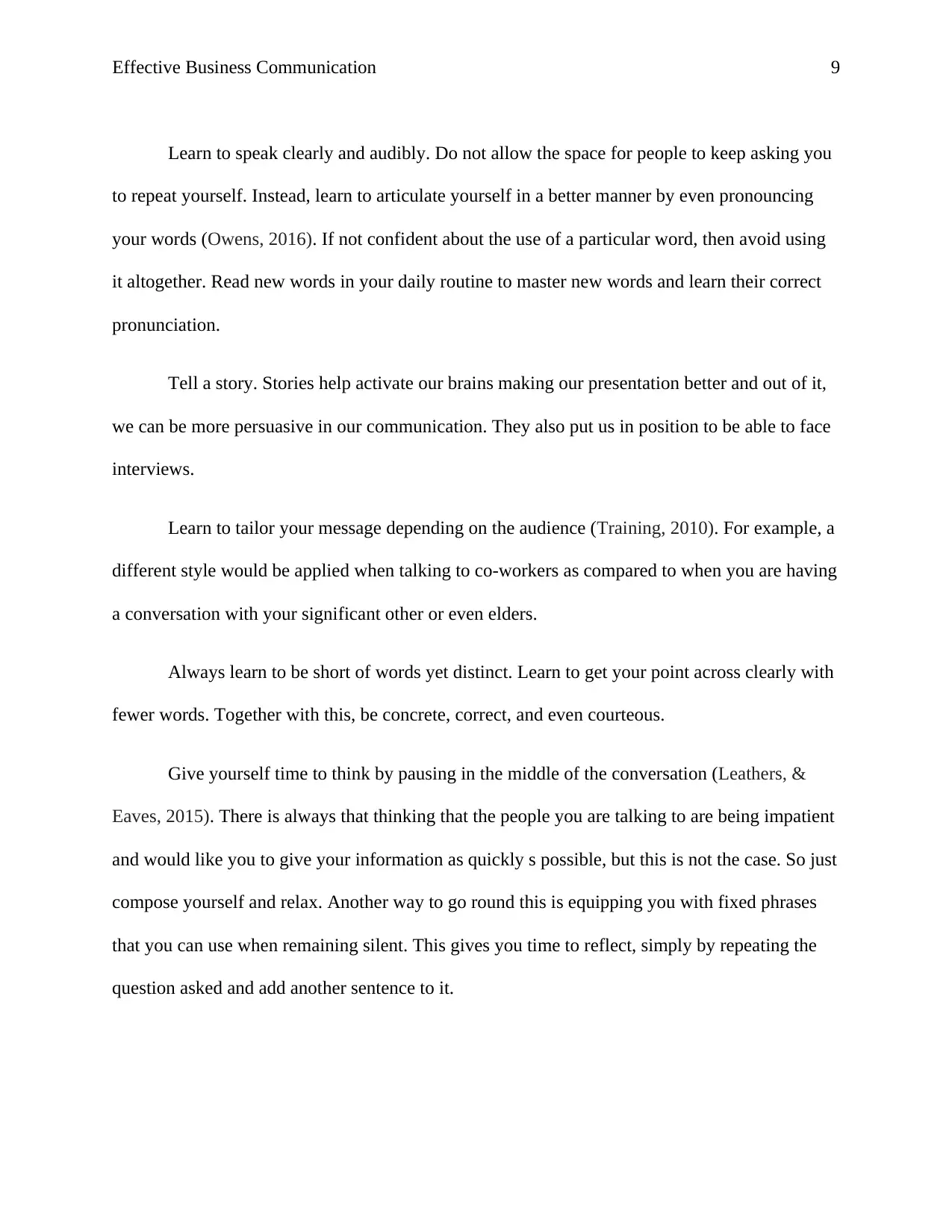
Effective Business Communication 9
Learn to speak clearly and audibly. Do not allow the space for people to keep asking you
to repeat yourself. Instead, learn to articulate yourself in a better manner by even pronouncing
your words (Owens, 2016). If not confident about the use of a particular word, then avoid using
it altogether. Read new words in your daily routine to master new words and learn their correct
pronunciation.
Tell a story. Stories help activate our brains making our presentation better and out of it,
we can be more persuasive in our communication. They also put us in position to be able to face
interviews.
Learn to tailor your message depending on the audience (Training, 2010). For example, a
different style would be applied when talking to co-workers as compared to when you are having
a conversation with your significant other or even elders.
Always learn to be short of words yet distinct. Learn to get your point across clearly with
fewer words. Together with this, be concrete, correct, and even courteous.
Give yourself time to think by pausing in the middle of the conversation (Leathers, &
Eaves, 2015). There is always that thinking that the people you are talking to are being impatient
and would like you to give your information as quickly s possible, but this is not the case. So just
compose yourself and relax. Another way to go round this is equipping you with fixed phrases
that you can use when remaining silent. This gives you time to reflect, simply by repeating the
question asked and add another sentence to it.
Learn to speak clearly and audibly. Do not allow the space for people to keep asking you
to repeat yourself. Instead, learn to articulate yourself in a better manner by even pronouncing
your words (Owens, 2016). If not confident about the use of a particular word, then avoid using
it altogether. Read new words in your daily routine to master new words and learn their correct
pronunciation.
Tell a story. Stories help activate our brains making our presentation better and out of it,
we can be more persuasive in our communication. They also put us in position to be able to face
interviews.
Learn to tailor your message depending on the audience (Training, 2010). For example, a
different style would be applied when talking to co-workers as compared to when you are having
a conversation with your significant other or even elders.
Always learn to be short of words yet distinct. Learn to get your point across clearly with
fewer words. Together with this, be concrete, correct, and even courteous.
Give yourself time to think by pausing in the middle of the conversation (Leathers, &
Eaves, 2015). There is always that thinking that the people you are talking to are being impatient
and would like you to give your information as quickly s possible, but this is not the case. So just
compose yourself and relax. Another way to go round this is equipping you with fixed phrases
that you can use when remaining silent. This gives you time to reflect, simply by repeating the
question asked and add another sentence to it.
Secure Best Marks with AI Grader
Need help grading? Try our AI Grader for instant feedback on your assignments.
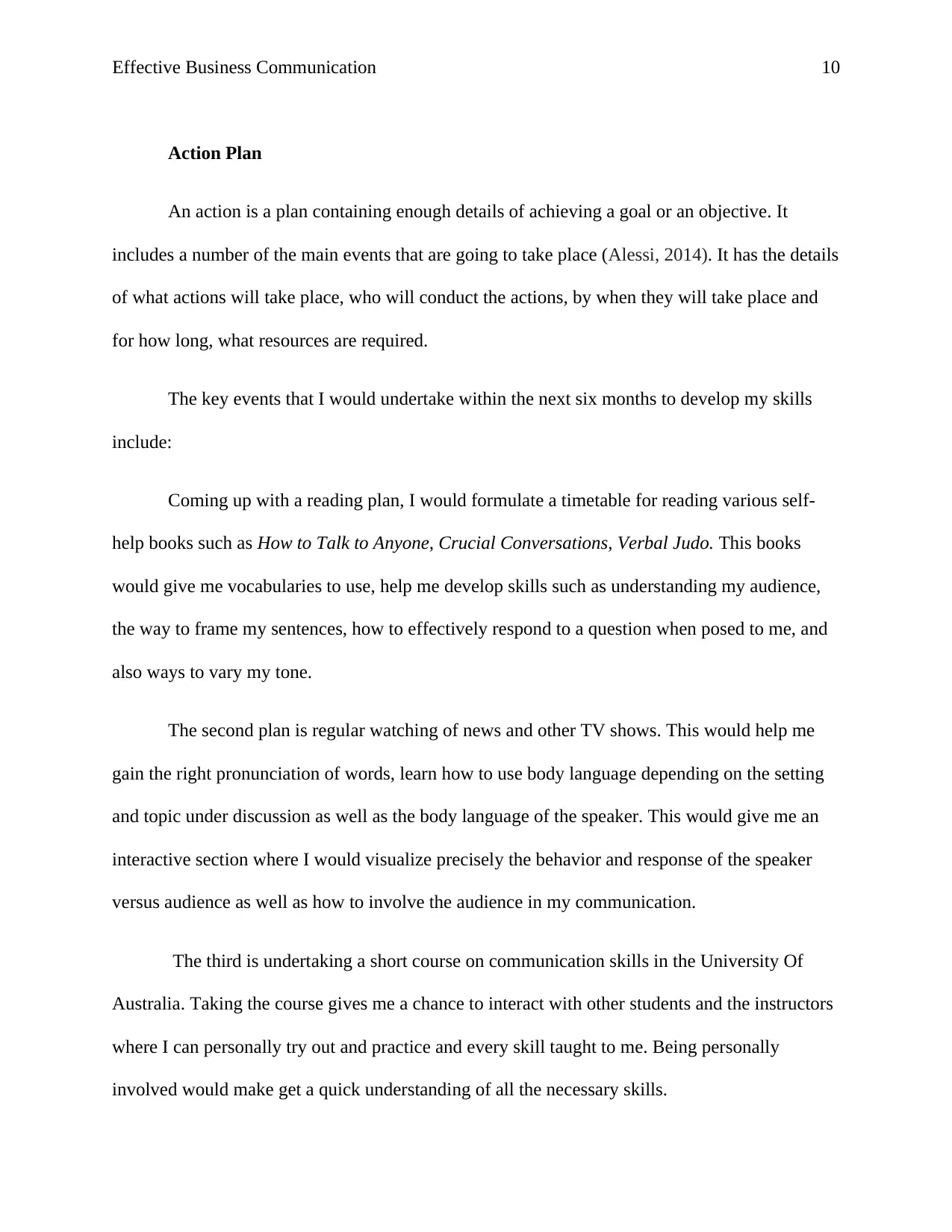
Effective Business Communication 10
Action Plan
An action is a plan containing enough details of achieving a goal or an objective. It
includes a number of the main events that are going to take place (Alessi, 2014). It has the details
of what actions will take place, who will conduct the actions, by when they will take place and
for how long, what resources are required.
The key events that I would undertake within the next six months to develop my skills
include:
Coming up with a reading plan, I would formulate a timetable for reading various self-
help books such as How to Talk to Anyone, Crucial Conversations, Verbal Judo. This books
would give me vocabularies to use, help me develop skills such as understanding my audience,
the way to frame my sentences, how to effectively respond to a question when posed to me, and
also ways to vary my tone.
The second plan is regular watching of news and other TV shows. This would help me
gain the right pronunciation of words, learn how to use body language depending on the setting
and topic under discussion as well as the body language of the speaker. This would give me an
interactive section where I would visualize precisely the behavior and response of the speaker
versus audience as well as how to involve the audience in my communication.
The third is undertaking a short course on communication skills in the University Of
Australia. Taking the course gives me a chance to interact with other students and the instructors
where I can personally try out and practice and every skill taught to me. Being personally
involved would make get a quick understanding of all the necessary skills.
Action Plan
An action is a plan containing enough details of achieving a goal or an objective. It
includes a number of the main events that are going to take place (Alessi, 2014). It has the details
of what actions will take place, who will conduct the actions, by when they will take place and
for how long, what resources are required.
The key events that I would undertake within the next six months to develop my skills
include:
Coming up with a reading plan, I would formulate a timetable for reading various self-
help books such as How to Talk to Anyone, Crucial Conversations, Verbal Judo. This books
would give me vocabularies to use, help me develop skills such as understanding my audience,
the way to frame my sentences, how to effectively respond to a question when posed to me, and
also ways to vary my tone.
The second plan is regular watching of news and other TV shows. This would help me
gain the right pronunciation of words, learn how to use body language depending on the setting
and topic under discussion as well as the body language of the speaker. This would give me an
interactive section where I would visualize precisely the behavior and response of the speaker
versus audience as well as how to involve the audience in my communication.
The third is undertaking a short course on communication skills in the University Of
Australia. Taking the course gives me a chance to interact with other students and the instructors
where I can personally try out and practice and every skill taught to me. Being personally
involved would make get a quick understanding of all the necessary skills.
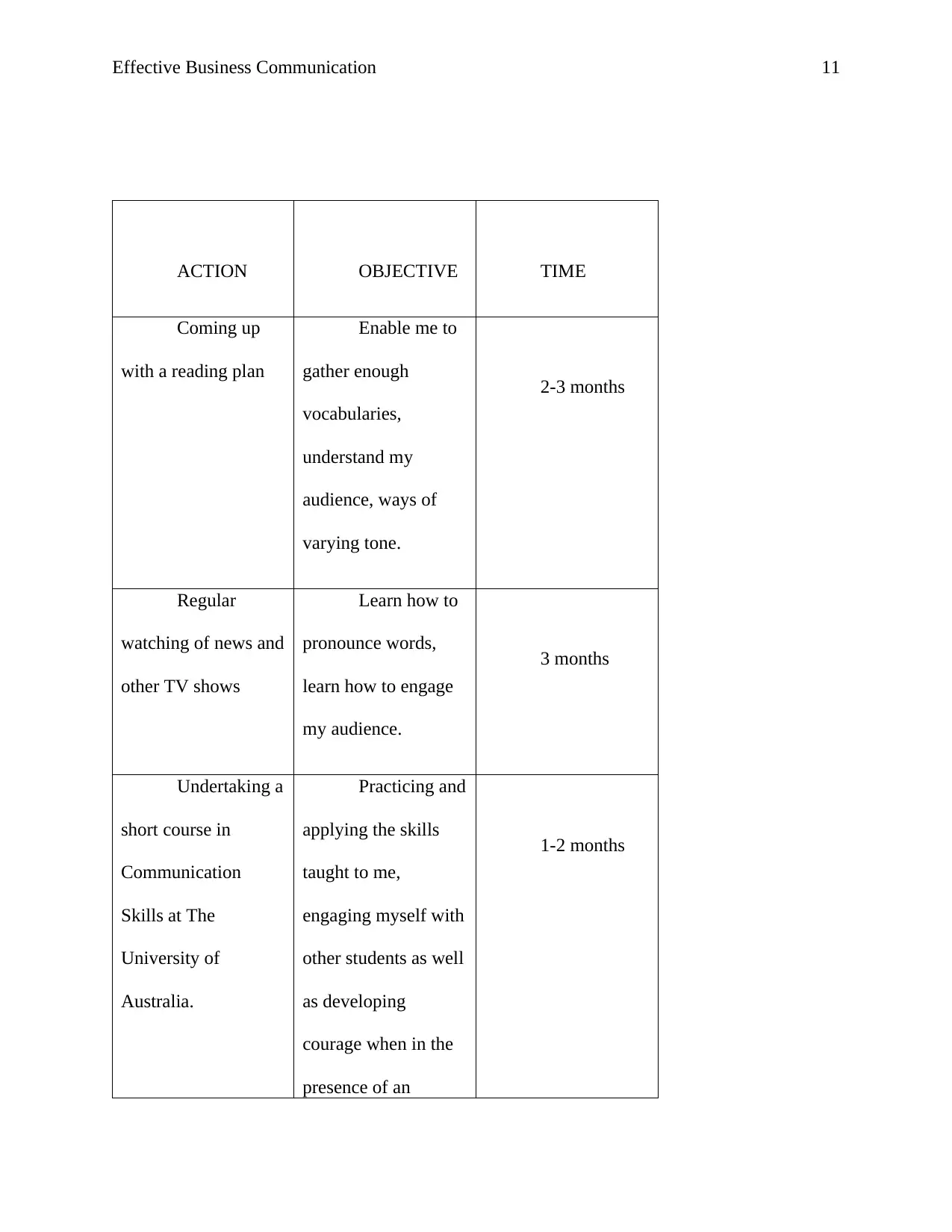
Effective Business Communication 11
ACTION OBJECTIVE TIME
Coming up
with a reading plan
Enable me to
gather enough
vocabularies,
understand my
audience, ways of
varying tone.
2-3 months
Regular
watching of news and
other TV shows
Learn how to
pronounce words,
learn how to engage
my audience.
3 months
Undertaking a
short course in
Communication
Skills at The
University of
Australia.
Practicing and
applying the skills
taught to me,
engaging myself with
other students as well
as developing
courage when in the
presence of an
1-2 months
ACTION OBJECTIVE TIME
Coming up
with a reading plan
Enable me to
gather enough
vocabularies,
understand my
audience, ways of
varying tone.
2-3 months
Regular
watching of news and
other TV shows
Learn how to
pronounce words,
learn how to engage
my audience.
3 months
Undertaking a
short course in
Communication
Skills at The
University of
Australia.
Practicing and
applying the skills
taught to me,
engaging myself with
other students as well
as developing
courage when in the
presence of an
1-2 months
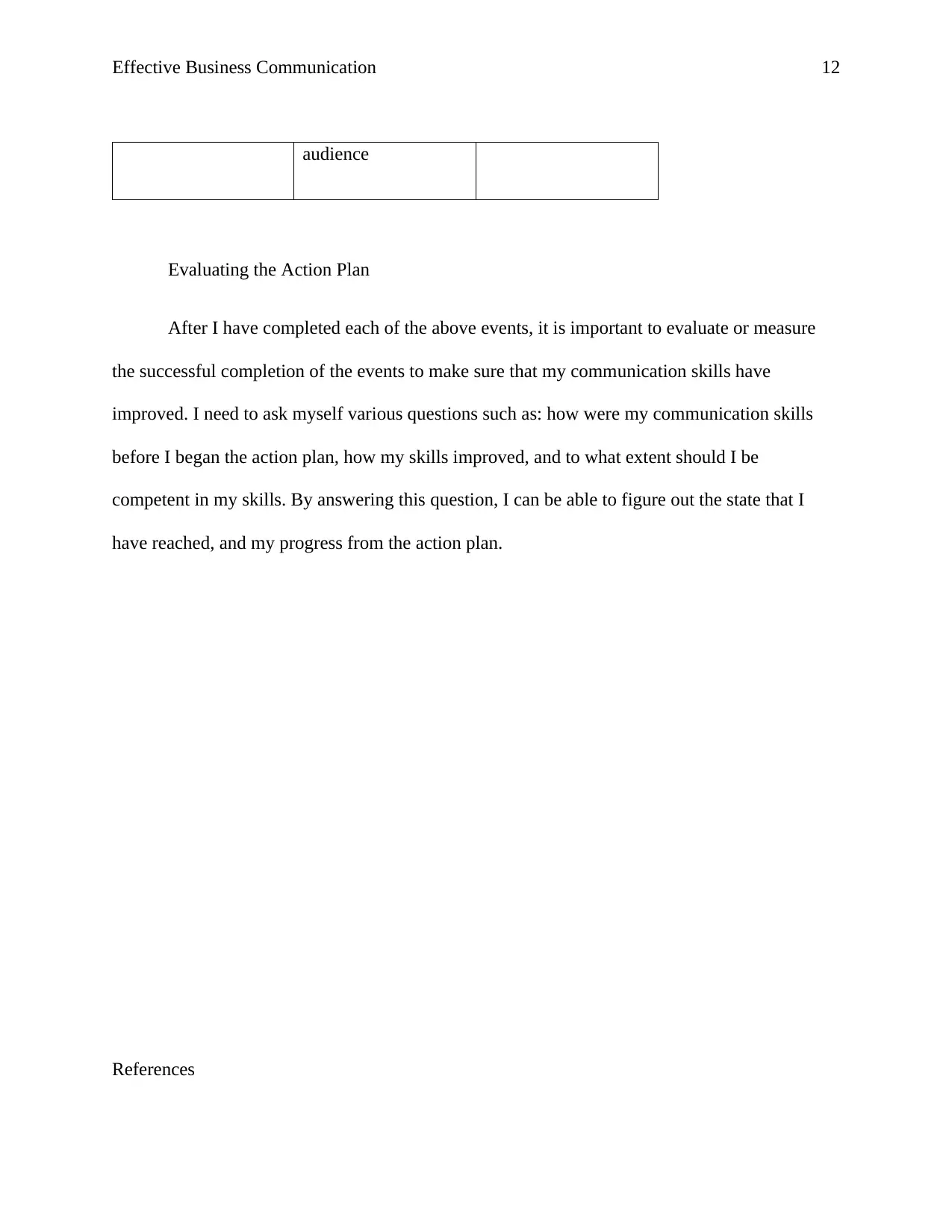
Effective Business Communication 12
audience
Evaluating the Action Plan
After I have completed each of the above events, it is important to evaluate or measure
the successful completion of the events to make sure that my communication skills have
improved. I need to ask myself various questions such as: how were my communication skills
before I began the action plan, how my skills improved, and to what extent should I be
competent in my skills. By answering this question, I can be able to figure out the state that I
have reached, and my progress from the action plan.
References
audience
Evaluating the Action Plan
After I have completed each of the above events, it is important to evaluate or measure
the successful completion of the events to make sure that my communication skills have
improved. I need to ask myself various questions such as: how were my communication skills
before I began the action plan, how my skills improved, and to what extent should I be
competent in my skills. By answering this question, I can be able to figure out the state that I
have reached, and my progress from the action plan.
References
Paraphrase This Document
Need a fresh take? Get an instant paraphrase of this document with our AI Paraphraser
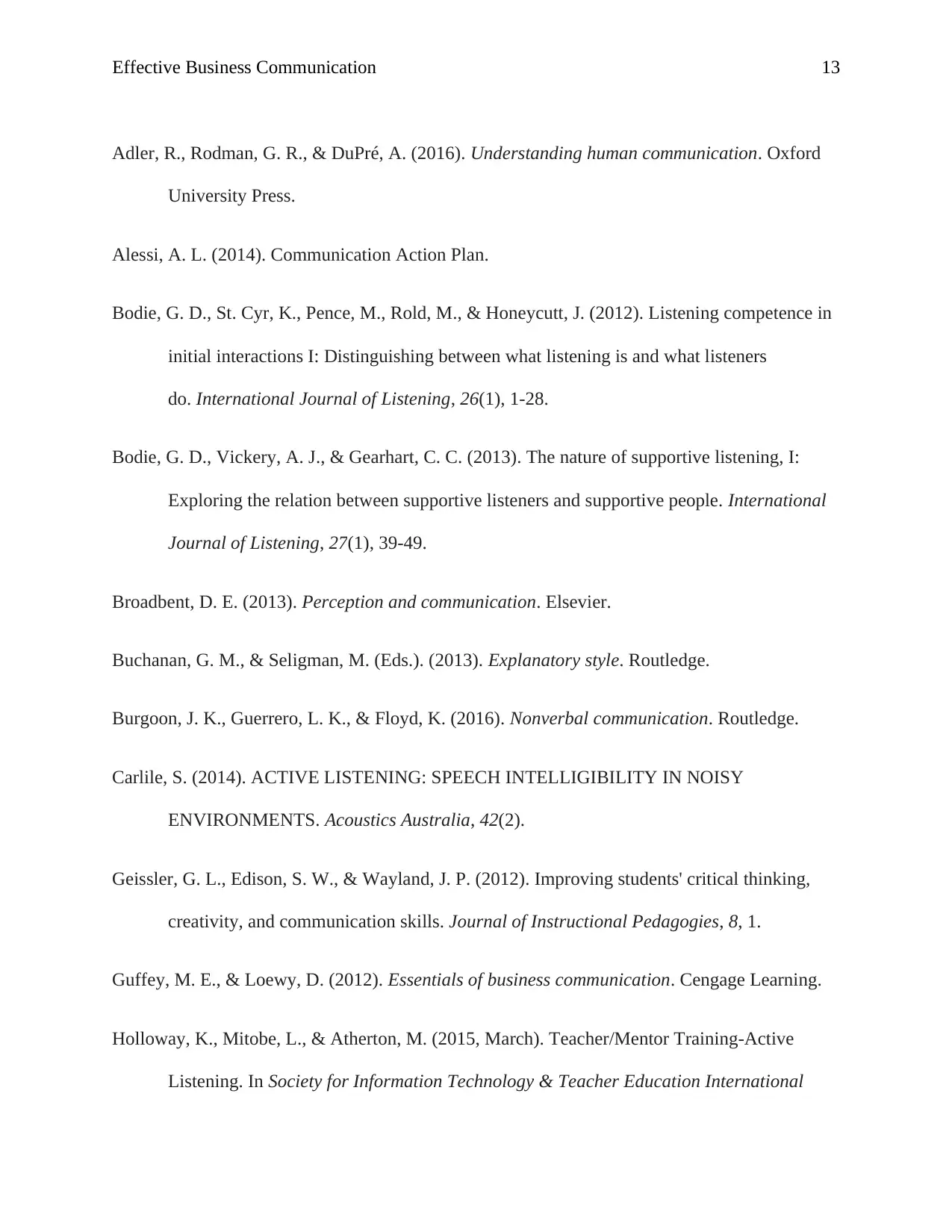
Effective Business Communication 13
Adler, R., Rodman, G. R., & DuPré, A. (2016). Understanding human communication. Oxford
University Press.
Alessi, A. L. (2014). Communication Action Plan.
Bodie, G. D., St. Cyr, K., Pence, M., Rold, M., & Honeycutt, J. (2012). Listening competence in
initial interactions I: Distinguishing between what listening is and what listeners
do. International Journal of Listening, 26(1), 1-28.
Bodie, G. D., Vickery, A. J., & Gearhart, C. C. (2013). The nature of supportive listening, I:
Exploring the relation between supportive listeners and supportive people. International
Journal of Listening, 27(1), 39-49.
Broadbent, D. E. (2013). Perception and communication. Elsevier.
Buchanan, G. M., & Seligman, M. (Eds.). (2013). Explanatory style. Routledge.
Burgoon, J. K., Guerrero, L. K., & Floyd, K. (2016). Nonverbal communication. Routledge.
Carlile, S. (2014). ACTIVE LISTENING: SPEECH INTELLIGIBILITY IN NOISY
ENVIRONMENTS. Acoustics Australia, 42(2).
Geissler, G. L., Edison, S. W., & Wayland, J. P. (2012). Improving students' critical thinking,
creativity, and communication skills. Journal of Instructional Pedagogies, 8, 1.
Guffey, M. E., & Loewy, D. (2012). Essentials of business communication. Cengage Learning.
Holloway, K., Mitobe, L., & Atherton, M. (2015, March). Teacher/Mentor Training-Active
Listening. In Society for Information Technology & Teacher Education International
Adler, R., Rodman, G. R., & DuPré, A. (2016). Understanding human communication. Oxford
University Press.
Alessi, A. L. (2014). Communication Action Plan.
Bodie, G. D., St. Cyr, K., Pence, M., Rold, M., & Honeycutt, J. (2012). Listening competence in
initial interactions I: Distinguishing between what listening is and what listeners
do. International Journal of Listening, 26(1), 1-28.
Bodie, G. D., Vickery, A. J., & Gearhart, C. C. (2013). The nature of supportive listening, I:
Exploring the relation between supportive listeners and supportive people. International
Journal of Listening, 27(1), 39-49.
Broadbent, D. E. (2013). Perception and communication. Elsevier.
Buchanan, G. M., & Seligman, M. (Eds.). (2013). Explanatory style. Routledge.
Burgoon, J. K., Guerrero, L. K., & Floyd, K. (2016). Nonverbal communication. Routledge.
Carlile, S. (2014). ACTIVE LISTENING: SPEECH INTELLIGIBILITY IN NOISY
ENVIRONMENTS. Acoustics Australia, 42(2).
Geissler, G. L., Edison, S. W., & Wayland, J. P. (2012). Improving students' critical thinking,
creativity, and communication skills. Journal of Instructional Pedagogies, 8, 1.
Guffey, M. E., & Loewy, D. (2012). Essentials of business communication. Cengage Learning.
Holloway, K., Mitobe, L., & Atherton, M. (2015, March). Teacher/Mentor Training-Active
Listening. In Society for Information Technology & Teacher Education International
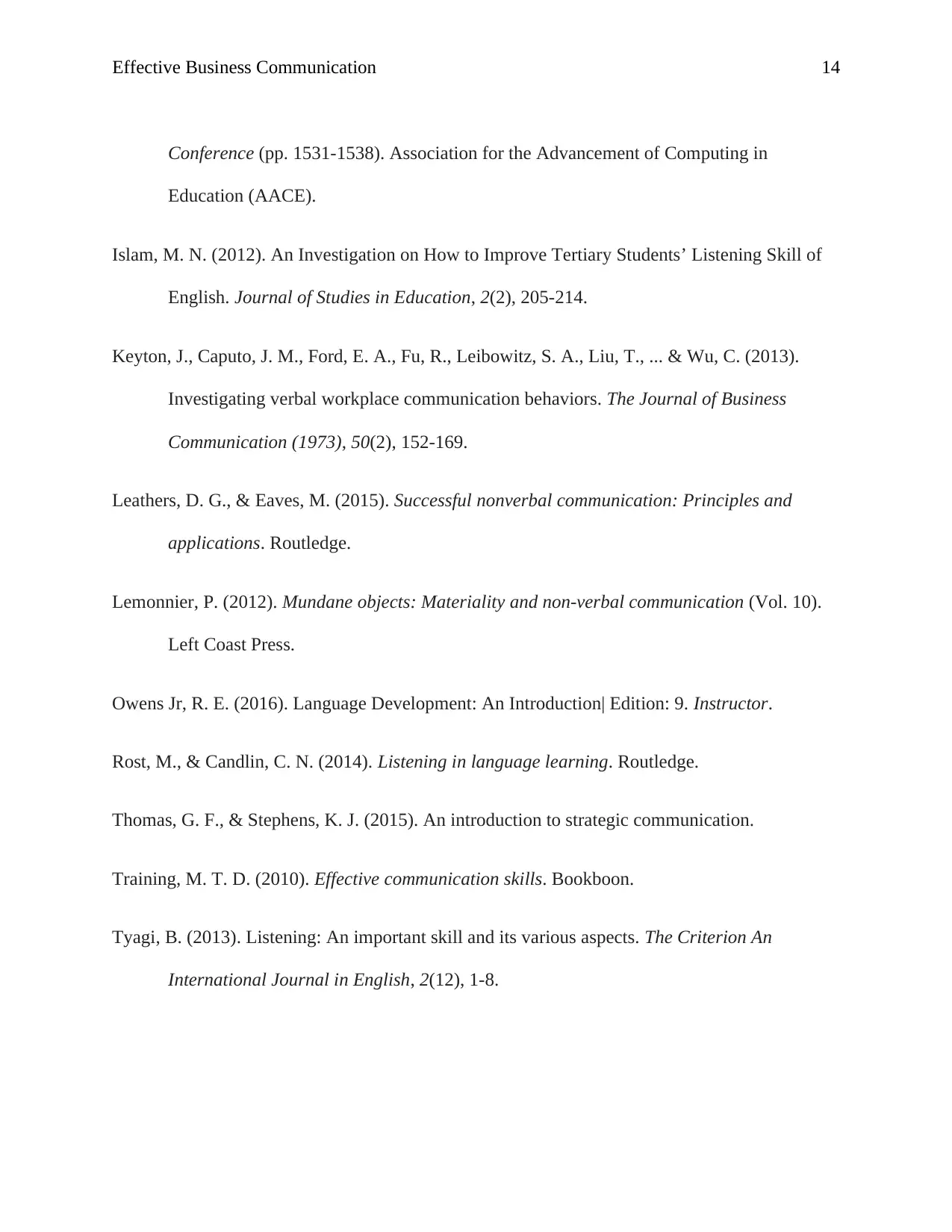
Effective Business Communication 14
Conference (pp. 1531-1538). Association for the Advancement of Computing in
Education (AACE).
Islam, M. N. (2012). An Investigation on How to Improve Tertiary Students’ Listening Skill of
English. Journal of Studies in Education, 2(2), 205-214.
Keyton, J., Caputo, J. M., Ford, E. A., Fu, R., Leibowitz, S. A., Liu, T., ... & Wu, C. (2013).
Investigating verbal workplace communication behaviors. The Journal of Business
Communication (1973), 50(2), 152-169.
Leathers, D. G., & Eaves, M. (2015). Successful nonverbal communication: Principles and
applications. Routledge.
Lemonnier, P. (2012). Mundane objects: Materiality and non-verbal communication (Vol. 10).
Left Coast Press.
Owens Jr, R. E. (2016). Language Development: An Introduction| Edition: 9. Instructor.
Rost, M., & Candlin, C. N. (2014). Listening in language learning. Routledge.
Thomas, G. F., & Stephens, K. J. (2015). An introduction to strategic communication.
Training, M. T. D. (2010). Effective communication skills. Bookboon.
Tyagi, B. (2013). Listening: An important skill and its various aspects. The Criterion An
International Journal in English, 2(12), 1-8.
Conference (pp. 1531-1538). Association for the Advancement of Computing in
Education (AACE).
Islam, M. N. (2012). An Investigation on How to Improve Tertiary Students’ Listening Skill of
English. Journal of Studies in Education, 2(2), 205-214.
Keyton, J., Caputo, J. M., Ford, E. A., Fu, R., Leibowitz, S. A., Liu, T., ... & Wu, C. (2013).
Investigating verbal workplace communication behaviors. The Journal of Business
Communication (1973), 50(2), 152-169.
Leathers, D. G., & Eaves, M. (2015). Successful nonverbal communication: Principles and
applications. Routledge.
Lemonnier, P. (2012). Mundane objects: Materiality and non-verbal communication (Vol. 10).
Left Coast Press.
Owens Jr, R. E. (2016). Language Development: An Introduction| Edition: 9. Instructor.
Rost, M., & Candlin, C. N. (2014). Listening in language learning. Routledge.
Thomas, G. F., & Stephens, K. J. (2015). An introduction to strategic communication.
Training, M. T. D. (2010). Effective communication skills. Bookboon.
Tyagi, B. (2013). Listening: An important skill and its various aspects. The Criterion An
International Journal in English, 2(12), 1-8.
1 out of 15
Related Documents
Your All-in-One AI-Powered Toolkit for Academic Success.
+13062052269
info@desklib.com
Available 24*7 on WhatsApp / Email
![[object Object]](/_next/static/media/star-bottom.7253800d.svg)
Unlock your academic potential
© 2024 | Zucol Services PVT LTD | All rights reserved.





